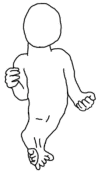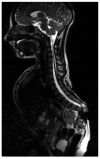Caudal Regression Syndrome-A Narrative Review: An Orthopedic Point of View
- PMID: 36980147
- PMCID: PMC10047641
- DOI: 10.3390/children10030589
Caudal Regression Syndrome-A Narrative Review: An Orthopedic Point of View
Abstract
Abnormalities in cellular differentiation during embryo-fetal period may lead to various malformations of the spine. Caudal regression syndrome (CRS) is a group of defects with premature growth/development termination of the vertebral column. CRS can be divided into three types: sirenomelia, complete absence of the sacrum and partial absence of the sacrum. Genitourinary and gastrointestinal anomalies are common, with neurogenic bladder and bowel incontinence. Treatment of patients with CRS is complex and multidisciplinary and should be comprehensive. The most common orthopedic problems are: spinal deformity (kyphosis and scoliosis), spinopelvic instability and lower limbs deformities.
Keywords: caudal regression syndrome; pediatric spine; sacral agenesis.
Conflict of interest statement
The authors declare no conflict of interest.
Figures







Similar articles
-
Continence management in children with severe caudal regression syndrome: role of multidisciplinary team and long-term follow-up.Pediatr Surg Int. 2022 Oct;38(10):1461-1472. doi: 10.1007/s00383-022-05168-1. Epub 2022 Aug 9. Pediatr Surg Int. 2022. PMID: 35943565
-
Pediatric cervical kyphosis in the MRI era (1984-2008) with long-term follow up: literature review.Childs Nerv Syst. 2022 Feb;38(2):361-377. doi: 10.1007/s00381-021-05409-z. Epub 2021 Nov 22. Childs Nerv Syst. 2022. PMID: 34806157 Review.
-
Retinoic acid-induced caudal regression syndrome in the mouse fetus.Reprod Toxicol. 1998 Mar-Apr;12(2):139-51. doi: 10.1016/s0890-6238(97)00153-6. Reprod Toxicol. 1998. PMID: 9535508
-
Lumbar agenesis with sacral sparing: a case report.J Neuroimaging. 1999 Jul;9(3):184-7. doi: 10.1111/jon199993184. J Neuroimaging. 1999. PMID: 10436763
-
Clinical and radiological evaluation of caudal regression syndrome.Pediatr Radiol. 2024 Aug;54(9):1451-1461. doi: 10.1007/s00247-024-05945-1. Epub 2024 May 16. Pediatr Radiol. 2024. PMID: 38750326 Review.
Cited by
-
Caudal regression syndrome with incidental brain tumor in a woman: A case report.Radiol Case Rep. 2024 Sep 28;19(12):6603-6608. doi: 10.1016/j.radcr.2024.09.073. eCollection 2024 Dec. Radiol Case Rep. 2024. PMID: 39380817 Free PMC article.
-
Radiological and clinical aspect of Caudal regression syndrome associated with dorsal hemivertebra without maternal diabetes.Radiol Case Rep. 2024 Jun 6;19(8):3548-3551. doi: 10.1016/j.radcr.2024.05.002. eCollection 2024 Aug. Radiol Case Rep. 2024. PMID: 38948903 Free PMC article.
-
Molecular mechanism, diagnosis, and treatment of VACTERL association.Front Pediatr. 2025 Jul 7;13:1609624. doi: 10.3389/fped.2025.1609624. eCollection 2025. Front Pediatr. 2025. PMID: 40692799 Free PMC article. Review.
-
Positive Evolution of a Child Suffering from Caudal Regression Syndrome and Agenesia Sacra After Treatment with Growth Hormone and Rehabilitation.Int J Mol Sci. 2025 Feb 14;26(4):1627. doi: 10.3390/ijms26041627. Int J Mol Sci. 2025. PMID: 40004100 Free PMC article.
-
Sacral Agenesis Type II in a 12-Year-Old Patient: A Delayed Presentation in a Low-Resource Setting.Cureus. 2025 Jun 28;17(6):e86903. doi: 10.7759/cureus.86903. eCollection 2025 Jun. Cureus. 2025. PMID: 40726883 Free PMC article.
References
-
- Esposito G., Totonelli G., Iacobelli B.D., Longo D., Caldaro T., Blasetti G., Bevilacqua F., Santato F., Lucignani G., Sollini M.L., et al. Continence management in children with severe caudal regression syndrome: Role of multidisciplinary team and long-term follow-up. Pediatr. Surg. Int. 2022;38:1461–1472. doi: 10.1007/s00383-022-05168-1. - DOI - PubMed
Publication types
LinkOut - more resources
Full Text Sources

